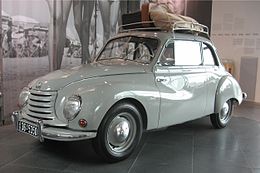DKW F91
| DKW | |
|---|---|
|
DKW F91 special class Cabriolet
|
|
| F91 special class | |
| Production period: | 1953-1957 |
| Class : | Lower middle class |
| Body versions : | Sedan , coupé , convertible , station wagon |
| Engines: |
Otto engine : 0.9 liters (25 kW) |
| Length: | 4170-4225 mm |
| Width: | 1520-1595 mm |
| Height: | 1450-1555 mm |
| Wheelbase : | 2350-2500 mm |
| Empty weight : | 895 kg |
| Previous model | DKW F89 |
| successor | DKW F93 |
The DKW Sonderklasse was an Auto Union car that appeared at the International Motor Show (IAA) in Frankfurt in March 1953 . It had the internal name Type F91 and largely corresponded to the DKW F9 planned for 1940 . While its predecessor, the DKW F89, in contrast to the IFA F9, was still powered by the two-cylinder engine of the DKW F8 (hence the DKW F8-9 ), the F91 had a three-cylinder engine , hence the DKW F9-1 .
General
From March 1953 to September 1955 57,407 sedans and coupes were produced in Düsseldorf, and Karmann also produced 1,550 two- and four-seater convertibles. The Kombi Universal , which continued to be produced until June 1957, produced 15,193 units.
The special class differed from the DKW master class with a transversely installed two-cylinder two-stroke engine primarily through a three-cylinder engine with 897 cm³ displacement and 34 hp (25 kW) positioned lengthways in front of the front axle and a new gearbox lengthwise behind the axle with a steering wheel shift instead of the crutch shift on the dashboard. As before, it was a two-stroke engine with reverse scavenging and a partially synchronized gearbox (2nd and 3rd gear). There was also the freewheel typical of DKW again. As with the master class, the radiator was also behind the engine and not behind the grille in front. Innovations were inclined telescopic shock absorbers on the rear suspension axis .
Externally, the special class differed from its predecessor by a radiator grille with only five instead of nine transverse strips. From 1954 it was also available as a four-seater coupé with a rear panoramic window , as seen at the 1953 IAA. The coupé had fully retractable side windows at the front and rear and no B-pillar (" hardtop coupé "). The manufacturer's advertisement highlighted the headlight flasher, fuel gauge and automatic switch-on of the interior lighting when the right door is opened as special equipment details.
Technical specifications
| Vehicle type: | DKW F91 special class | |
|---|---|---|
| Engine: | 3-cylinder in-line two-stroke | |
| Displacement : | 896 cc | |
| Bore × stroke: | 71 mm × 76 mm | |
| Power: | 25 kW (34 PS) at 4000 rpm | |
| Compression: | 6.5: 1 | |
| Cooling: | Water cooling ( thermosiphon ), fan driven by V-belt | |
| Carburetor: | 1 Solex downdraft 40 BIC or 40 ICB | |
| Lubrication: | Fuel-oil mixture 1:25 | |
| Transmission: | 3-speed gearbox * with freewheel (2nd and 3rd gear synchronized), steering wheel shift | |
| Front suspension: | Lower wishbones and high transverse leaf springs, telescopic shock absorbers | |
| Rear suspension: | Rigid axle ( floating axle ) on trailing arms and high transverse leaf spring, telescopic shock absorber | |
| Body: | Box frame with all-steel body | |
| Steering: | Rack and pinion steering | |
| Brakes: | hydraulically operated drum brakes, front duplex | |
| Wheelbase : | 2350 mm (universal: 2500 mm) | |
| Track width front / rear: | 1190/1250 mm | |
| Wheel size: | 5.60-15 | |
| Dimensions L × W × H: | 4225 mm × 1595 mm × 1450 mm (universal: 4170 mm × 1520 mm × 1555 mm) | |
| Dead weight (without fuel): | 895 kg | |
| Top speed: | 115 km / h (factory specification) | |
- Towards the end of the relatively short construction period, a 4-speed gearbox was available (second to fourth gear synchronized).
The advertising awarded the three-cylinder two-stroke engine the smoothness and freedom from vibrations of a six-cylinder four-stroke engine, which was almost achieved. The standard consumption according to DIN 70030 (with a constant three quarters of the maximum speed, but no more than 110 km / h, on a flat stretch) was relatively low at 7.8 l / 100 km.
Literature and Sources
- Peter Kurz: DKW master class. Delius Klasing Verlag, Bielefeld 2005, ISBN 3-7688-1646-X .
- Siegfried Rauch: DKW - The story of a global brand. Motorbuch Verlag, Stuttgart 1988, ISBN 3-87943-759-9 .
- Car and motorcycle world. Issue 6/1953.
Web links
Individual evidence
- ↑ Auto Union (Ed.): Special Issue 1 - Carburetor / AB 2085 . 1960.




